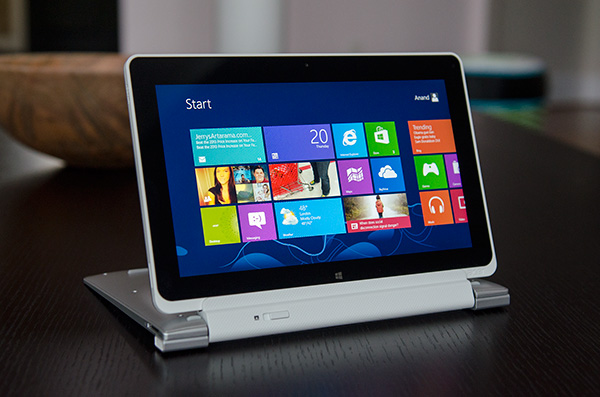The Clover Trail (Atom Z2760) Review: Acer's W510 Tested
by Anand Lal Shimpi on December 20, 2012 10:34 AM ESTReflecting on Windows 8
In our Surface, VivoTab RT and Windows RT reviews both Vivek and I were fairly positive on Windows RT and the new modern user interface that Microsoft introduced with it and Windows 8. My feelings on the OS haven’t really changed since then, I still believe Windows 8 is a good step forward for Microsoft. The improvements to the underlying OS make it a good upgrade for current desktop/notebook users, while the modern UI makes it a great solution for tablets.
Windows RT/8 have sold me on touch when it comes to a notebook or notebook hybrid. I do wonder how much having a good touch experience is necessary when your trackpad experience isn’t perfect, but I find myself touching the screen on older notebooks more than ever before when switching between Windows RT/8 and other systems. I don’t believe ubiquitous touch is going to spell certain success for Microsoft, but it’s a good move.
I also can’t stress enough how big of a deal it is that Microsoft has delivered a power efficient OS capable of hanging with Android and iOS. It wasn’t that long ago where idle battery life on PCs significantly lagged behind even OS X, and now we’re talking about Windows experiences that rival ultra mobile OSes.
The big issue with Windows RT/8 is that the experience as a whole seems to be unfinished. Microsoft has done nothing to advance the traditional desktop UI paradigm. Keyboard/mouse navigation within the modern UI is functional, but it feels like more of a concession rather than an optimized experience. Microsoft of course needs to push the modern UI in order to quickly ramp up its app library. It’s a difficult position to be in and I don’t necessarily know of a better solution that delivers what MS wants while prioritizing the end user experience. Microsoft was one of the first companies to learn that for each device vertical, a custom user experience is necessary (e.g. Media Center Edition, Xbox). Wherever it has failed to keep those learnings in mind, things eventually end up going south. Sometimes it takes a while (Windows Mobile) and sometimes it’s apparent almost immediately (Tablet PC Edition). The fact that tablets/smartphones are the new high-growth markets definitely tilts things in Microsoft’s favor this time around, but that doesn’t mean that Microsoft is out of the woods.
Transitioning between modern and desktop UIs remains abrupt. I wanted to write about this in our Surface review but ran out of time. There's this weird bimodal UI paradigm that exists within Windows RT/8. Microsoft forces you into the modern UI by default, but sometimes it'll vomit you out into the desktop UI without warning depending on what you click. Want additional connection properties about your WiFi network? You're back in desktop mode.
Even within the modern UI there are some things that don’t seem well thought out. If you want OS/firmware updates, you’ll have to navigate to Windows Update - but if you want to update your apps you need to go through the Store app for those.
When it comes to performance, there are still quite a few annoyances. IE10 is better than expected, but it's in dire need of a performance boost. The swipe to go back to a previous page gesture is great for example, but the time it takes to switch from a pre-rendered screenshot to the actual page is unacceptably long.
Many fundamental tasks/apps still take way too long to respond with no real indication of what’s going on. I noticed I had 32 updates in the Store, clicked on the updates link and got this screen for minutes without anything happening:
The same is true for Mail, here's a screen i was faced with while mail tried to connect to my mail server. The process wasn’t quick, i was faced with this screen for dozens of seconds:
The problem when this happens is there’s usually no way to easily back out of the task or even get an idea of the progress of the task. The obvious solution here is there shouldn’t be so many situations where activity happens but no progress is made for a while. The issues aren’t always common but when they happen, they’re annoying and seem to be far less present on Android/iOS. Things just feel like they were rushed.
Microsoft needs to think about winning over Apple/Android users in a major way, as well as addressing their existing user base. There's clearly potential with Windows 8, but the usual model of minor updates that focus on under the hood fixes with major UI updates saved for major releases of the OS needs to go. I don't even know if an annual UI tweak is enough for MS to make up ground here. Microsoft has 12 - 18 months before Apple throws its hat into the converged tablet/notebook game, that's the window of opportunity to make Windows RT/8 a success. Otherwise, the exodus continues.
Microsoft had better not treat Windows 8 like it did Windows Phone 7 and not substantially update the UI for 2 years.













104 Comments
View All Comments
strangis - Thursday, December 20, 2012 - link
"Which means nothing, as these mobile chips are too underpowered to actually run the desktop x86 applications"My ATIV 500 painting an 11x17 300dpi multilayer image in Sketchbook Pro with the active digitizer smoothly disagrees with your assumption.
Just saying.
Wolfpup - Thursday, January 3, 2013 - link
Of COURSE they run desktop programs. They run Firefox, OpenOffice (and older versions of MS Office you might already own), media tools, IM clients, all SORTS of things that aren't available or even possible on other platforms.No, it won't reasonably run Skyrim, but there's a ton that it will run.
Personally I think this is pretty awesome...you get a good for the form factor CPU that oh yeah, happens to actually be compatible with what you have, and the price is the same as ARM stuff.
What's bad is the GPU...seems like they have almost a 2009 smartphone GPU in there rather than something more appropriate for 2013...and then there's the issue that metro is locked down, not a real PC...but then that's why you want an x86 tablet to begin with...at least you get the real desktop and in that mode it's a real PC.
jeffkro - Thursday, December 20, 2012 - link
Basically for tablets and phones I prefer the android "library" so intel/windows really isn't for me anyways.SM123456 - Wednesday, February 13, 2013 - link
Yes, but Microsoft has to use a x86 CPU if they are to be able run Windows apps.Basically this device and all other Windows 8 tablets under $600 are grossly overpriced netbooks with touch added and a keyboard taken away.
The $199 Acer C7 Chromebook with its 1.1 GHz dual core Celeron processor is at least twice as fast as this thing.
Dribble - Thursday, December 20, 2012 - link
So we have windows RT that is optimised both around the ARM cpu's and tablets. There is no old software - everything that you can get for it should both run fine on tegra 3 and work well with a small touch screen. This means stuff should just work well - this is what apple do so well, and MS are trying to emulate.On the other hand there is full windows. Now the reason to get this not RT is backwards compatibility. Most *old* windows apps require higher performance cpu's (e.g core i3) a big screen, a mouse and a keyboard. They don't use touch at all.
Taking that into account an atom tablet has a screen that's too small, a cpu that's too slow and a bad mouse/keyboard experience - sure you could plug both in but then it's not really a tablet any longer is it? Also all that backward compatibility support uses effectively a different ui - it's not a clean and polished single interface. Stuff won't just work well - the experience won't be as good.
Hence if you want full windows you'd be much better off with a laptop/ultra book - they are still touch screen so you get any touch benefits but they have much faster cpu's, better keyboard, etc.
Shadowmaster625 - Thursday, December 20, 2012 - link
Not sure where you got that idea from. 99% of windows applications dont hardly use any cpu at all. Check task manager sometime. You will notice that most processes only consume a few seconds of cpu time per hour of system idle time. It is extremely rare for a windows application to peg even one cpu core to 100%.freedom4556 - Thursday, December 20, 2012 - link
You that that's a percentage and it depends on what CPU you're looking at right? That's like saying, "Yeah, I never need more than 1% of my horsepower even doing 150mph uphill in a headwind." when you drive a Lamborghini. Try it again in a Honda and you'll not even be able to do it, nevermind 100% usage.Do you have an i7 or an Atom?
B3an - Thursday, December 20, 2012 - link
One thing that stood out to me in this article, is the bugs/reboots you encountered. You pretty much blamed them on Win 8, or made it sound that way. Which i thought was unprofessional, especially for you Anand. As theres a very good chance they're to do with a particular app, drivers on this device, or even it's hardware. Win 8 is a very solid stable OS, even more so than Win 7 on release.ltcommanderdata - Thursday, December 20, 2012 - link
True. But hasn't it always been the case that app and driver instability gets fairly or unfairly associated with Windows? At the same time, when things are working well, Microsoft is happy if you think of yourself as enjoying a "Windows" PC or tablet regardless of what particular software or hardware you are using in/on Windows. I guess we'll have to see how common problems are with other CloverTrail tablets. If they show up in CloverTrail tablets from other manufacturers, then even if the underlying OS is stable it still becomes Microsoft's problem if people are having trouble developing reliable apps/drivers/tablet using it.Anand Lal Shimpi - Thursday, December 20, 2012 - link
The issue is these were first party apps developed by MS, and I've seen some evidence of the same on other non-W510 platforms (I just don't remember this being the case with Surface RT but I've been using these x86 platforms longer than I did Surface).I'm curious to read Vivek's take on the ATIV Smart PC to see if it mirrors my experience.
Take care,
Anand